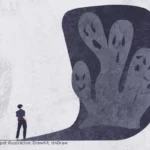
In our daily life we often use the words “pain” and “suffering” interchangeably. Pain causes suffering and suffering is painful, so both sensations in our mind are inextricably linked. However, there is a subtle difference between the two concepts, a difference that can make a big change about how to cope with life and adversity.
The main difference between pain and suffering lies in how dealing with problems, conflicts and difficulties that arise throughout the years. Pain is a feeling we experience when we live a situation that has had a negative impact on us.
It is an automatic response to something that hurts us, either physically or psychologically. So, we experience pain when we cut our finger and when we lose a loved one, when someone humiliates us or despises us.
From this perspective, pain is an answer that can’t be avoided as it is activated immediately after the event. However, at this point, we can choose between two options: accept the existence of pain and deal with it, or deny it and pretend it didn’t exist.
However, suffering is something else, is the result of the negative interpretation we give to pain over time. And in many cases, is precisely that meaning which increases our discomfort. Therefore, although pain may need to grow, suffering is unnecessary and limits us.
What happens in a suffering brain?
Suffering is generated from the negative meanings we give to certain painful situations, but remains because of our fear of experiencing these negative emotions. When we deny or hide pain, what we are doing is to prevent the integration of the traumatic experience into our life experience, as a result, suffering remains active. If we don’t understand and accept pain, if we don’t give it a meaning, we prevent it from integrating as a narrative experience, as a neutral content, then it will continue treasuring its negative valence.
In fact, it has been appreciated that when we live a particularly painful or traumatic experience in our brain occurs biochemical deregulations. In practice, the amygdala is keeping active because perceives that danger still exists, although it’s not.
That hyperarousal increases the levels of cortisol, a hormone that inhibits the function of the hippocampus, the structure responsible for processing the experiences we live, giving them a meaning and placing them in our memory.
Therefore, until we’re perceiving the painful experience as a threat, until we’re not ready to face this, we won’t be able to assume it and this will cause suffering. However, this suffering will not lead us anywhere.
Changing the meaning of pain
In an experiment conducted at the Universities of Massachusetts and Stanford, the researchers introduced to participants a series of images that aroused negative emotions. However, some were asked to attempt changing their meaning to cease experiencing those negative emotions.
Thus, it was observed that people who were able to find alternative explanations could change their negative emotions. Therefore, cognitive restructuring is a particularly effective technique to deal with the suffering generated from pain. In practice, it is about changing negative emotions, changing the meaning we ascribe to certain facts. How we can achieve this?
1. Identify thoughts that cause suffering. Very often these thoughts are based on distorted forms of seeing the reality, an exaggeration of the consequences or fear of not being able to cope with adversity. However, consider that what you feel is not real, it’s just a reaction to reality. Therefore, take pen and paper and write down the thoughts that bother you.
2. Evaluate thoughts. Analyze whether those thoughts truly reflect the reality, ask yourself: What evidence confirms what I think? Is that a partial or exaggerated interpretation? Then, you must analyze its consequences: Are these thoughts helpful? Can they help me feeling like I want? It is also convenient to imagine the worst consequences and wonder: Are they really that serious? What effect will have on my life in a year from now?
3. Find alternative thoughts. Finally, you have to replace those negative thoughts that feed the suffering with more positive or helpful ones. Of course, it doesn’t mean to deceive yourself or minimize the problems but to assume an attitude that helps you processing pain and move on. Therefore, ask yourself: How could I interpret more positively what is happening to me? What are the benefits I could get out of this situation? What I would say to my best friend if he were in the same situation?



